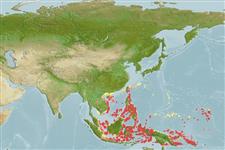>
Eupercaria/misc (Various families in series Eupercaria) >
Labridae (Wrasses) > Corinae
Etymology: Halichoeres: Greek, als, alis = salt + Greek, choiros = pig (Ref. 45335).
More on authors: Fowler & Bean.
Environment: milieu / climate zone / depth range / distribution range
Ecología
marino asociado a arrecife; rango de profundidad 1 - 15 m (Ref. 90102). Tropical; 30°N - 9°S
Western Pacific: Java, Philippines, Ryukyu Islands, Moluccas, Palau (Belau), Truk, Pohnpei, and Kwajalein.
Tamaño / Peso / Age
Maturity: Lm ? range ? - ? cm
Max length : 19.0 cm TL macho / no sexado; (Ref. 9710)
Short description
Claves de identificación | Morfología | Morfometría
Espinas dorsales (total) : 9; Radios blandos dorsales (total) : 12; Espinas anales: 3; Radios blandos anales: 12. Males are recognized by the orange-brown head and blue lines that are chain-like along the body. Juveniles and females have an orange to yellow anal fin. The snout is more pointed compared to similar species (Ref. 48636). Terminal males have a distinctive concave head profile (Ref. 1602).
Occurs in shallow lagoon and channel reefs, up to a depth of at least 12 m, with rich soft-coral growth. Occurs in small loose groups (Ref. 48636).
Life cycle and mating behavior
Maturities | Reproducción | Spawnings | Egg(s) | Fecundities | Larva
Distinct pairing during breeding (Ref. 205).
Myers, R.F., 1991. Micronesian reef fishes. Second Ed. Coral Graphics, Barrigada, Guam. 298 p. (Ref. 1602)
IUCN Red List Status (Ref. 130435)
Threat to humans
Harmless
Human uses
Herramientas
Special reports
Download XML
Fuentes de Internet
Estimates based on models
Preferred temperature (Ref.
123201): 27.5 - 29.3, mean 28.8 °C (based on 1088 cells).
Phylogenetic diversity index (Ref.
82804): PD
50 = 0.5000 [Uniqueness, from 0.5 = low to 2.0 = high].
Bayesian length-weight: a=0.00955 (0.00451 - 0.02020), b=3.09 (2.92 - 3.26), in cm total length, based on LWR estimates for this Genus-body shape (Ref.
93245).
Nivel trófico (Ref.
69278): 3.5 ±0.5 se; based on size and trophs of closest relatives
Resiliencia (Ref.
120179): Medio, población duplicada en un tiempo mínimo de 1.4-4.4 años (Preliminary K or Fecundity.).
Fishing Vulnerability (Ref.
59153): Low vulnerability (10 of 100).
Nutrients (Ref.
124155): Calcium = 78 [46, 131] mg/100g; Iron = 0.681 [0.394, 1.260] mg/100g; Protein = 18.5 [15.6, 20.7] %; Omega3 = 0.14 [0.09, 0.22] g/100g; Selenium = 20.9 [12.6, 37.9] μg/100g; VitaminA = 136 [42, 493] μg/100g; Zinc = 1.66 [1.15, 2.63] mg/100g (wet weight);
